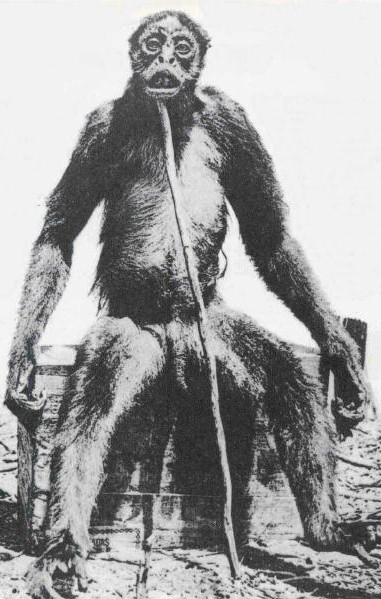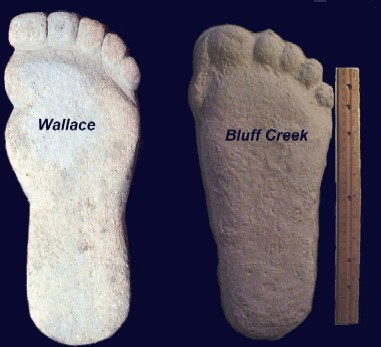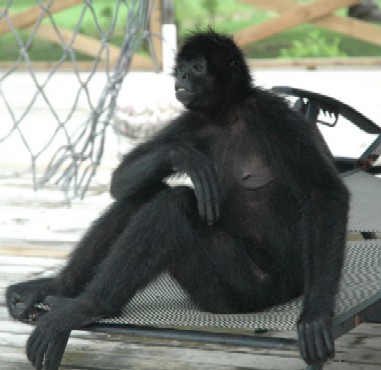Loren Coleman’s Top Ten Reasons For Cryptozoology Hoaxes
Posted by: Loren Coleman on April 1st, 2012

The cropped photograph of the so-called Ameranthropoides loysi, de Loys’ alleged “ape,” illustrates the political type of motive behind one of the most sinister hoaxes of all times (see #10 below).
My choices for the top ten major reasons that exist for hoaxing in cryptozoology are:
(1) fiscal gain (e.g. allegedly the reason behind a hoaxster’s “Coast to Coast AM” radio appearances was so the guest’s broadcast claims of a “captured Bigfoot” video he said he was going to post online would encourage “subscribers” to pay a fee to “see” it; in the case of the Georgia hoax, allegedly $50,000 was aquired);
(2) fifteen minutes of fame (e.g. the late Ivan Marx, the late Ray Wallace, the Georgia hoaxers, and other members of the hoaxing fraternity appear to have had a psychological need for media-attention, resulting in a temporary sense of celebrity);

Ray Wallace.
The late Mark Chorvinsky told Seattle Times reporter Bob Young in 2002, when asked to reply to Dr. Meldrum’s dismissal of the Ray Wallace hoaxes: “Jeff Meldrum is not an expert in creating hoaxes. I was a professional magician and special-effects film director; anything can be faked.”
(3) pranks (i.e., these can be April Fools ~ like John Green’s ~, harmless teen, misguided college or Halloween-style practical jokes that go overboard and become local legends);
(4) spreading misinformation (e.g. when I was doing research for Cryptozoology A to Z, an individual attempted to create an online history of sightings about the so-called “Ozark Howler,” so I would write an entry on them in my forthcoming book; his deception was discovered and not one paragraph exists therein on this fake cryptid);
(5) vandalism (i.e,. some hoaxing appears to be mischief, performed for psychological reasons only known to the creator, to cause disruptions for disruptions’ sake, in a display of misguided behavior in a powerless or mentally unbalanced person; some have called these purely “evil” acts);
(6) venting of anger or revenge targeting a specific group or individual (i.e., a few manufactured events are private personalized incidents that may get incidental local or national media attention, although the original non-media motive may be lost in the publicity that results);
(7) private exchanges gone bad (i.e., related to bragging, hoaxing, and pranks that spreads beyond a small circle of friends and foes, such as the faking of some Bigfoot prints in the Pacific Northwest by the late Ray Wallace and the late Rant Mullens, who claimed to be in a “Liars Club”)

Despite the media’s attempts to look for easy answers, the 1958 Bluff Creek-Jerry Crew Bigfoot tracks appear to not match Ray Wallace’s wooden fakery.
(8) misinterpreted jokes (e.g. these are funny gags that are misunderstood by others – botched – as discussing reality, discovered to be fiction, and thus have been labeled a hoax, perhaps inappropriately);
(9) discrediting a company or an individual (i.e. these appear to be different than #6 above, as the public media factor is built into the hoax, by design); and
(10) political reasons (e.g. the racism behind the photographs of spider monkeys taken by François De Loys in 1920 in Venezuela that have been passed off as unknown apes; the hoax was to support the eugenics theories of George Montandon, who was looking for an anthropoid precursor for the Native South Americans, just as he had said Africans evolved from gorillas and Asians from orangutans*; his theories were linked to the same ideas that the Nazis used against the Jewish, Roma people and other populations during the Holocaust).
De Loys’ “ape” (below) is nothing more than a spider monkey (with the tail hidden), similar to the one pictured (above), which you may enlarge by clicking on the image.

* “De Loys’s Photograph: A Short Tale of Apes in Green Hell, Spider Monkeys, and Ameranthropoides loysi as Tools of Racism” by Loren Coleman and Michel Raynal, in The Anomalist 4, Autumn 1996.
“Loren Coleman’s Top Ten Reasons For Cryptozoology Hoaxes” © Loren Coleman 2006, 2012.
About Loren Coleman
Loren Coleman is one of the world’s leading cryptozoologists, some say “the” leading living cryptozoologist. Certainly, he is acknowledged as the current living American researcher and writer who has most popularized cryptozoology in the late 20th and early 21st centuries.
Starting his fieldwork and investigations in 1960, after traveling and trekking extensively in pursuit of cryptozoological mysteries, Coleman began writing to share his experiences in 1969. An honorary member of Ivan T. Sanderson’s Society for the Investigation of the Unexplained in the 1970s, Coleman has been bestowed with similar honorary memberships of the North Idaho College Cryptozoology Club in 1983, and in subsequent years, that of the British Columbia Scientific Cryptozoology Club, CryptoSafari International, and other international organizations. He was also a Life Member and Benefactor of the International Society of Cryptozoology (now-defunct).
Loren Coleman’s daily blog, as a member of the Cryptomundo Team, served as an ongoing avenue of communication for the ever-growing body of cryptozoo news from 2005 through 2013. He returned as an infrequent contributor beginning Halloween week of 2015.
Coleman is the founder in 2003, and current director of the International Cryptozoology Museum in Portland, Maine.











Although later in life Ivan Marx did pull alot of hoaxes, I think it’s safe to say that he started out as a genuine investigator.
I think another reason my be that some people want something so bad to be true that they create a hoax merely to move the discussion forward. Probably not a top ten reason, but I do know of one person who did that (UFO hoax) with the purpose of creating more interest in the subject locally. His hoax was discovered but not because they promoted it for his own benefit, but because he tried hard to keep it in lime light and carelessly made observations that were too detail oriented. That caused some to get suspicious.
He finally confessed, which ruined his credibility, saying that nothing ever seemed to happen where he lived and he wanted people to get interested in the subject and thought that some local sensationalism would get people fired up.
Deloy’s ape will be a bone of contention for a long time. Scholars are divided over it. While Mr. Coleman makes a case for it being a hoax, others such as Ruppert Matthews makes the case for it being legit, noting some anatomical differences between the Ateles Spider Monkey (one possible canidate for the creature) and Deloy’s Ape, such as the more rounded oval shape of the latter as opposed to the more triangular shape seen more usually in modern Spider monkeys, greater size (the crates used to confirm Deloy’s over 5 feet height of the beast, though the crates are a controversial subject in and of themselves and are subsequently not reliable as an absolute measurement), and the fact that, though spider monkeys have 36 teeth (as opposed to Deloy’s, which had 32, evidence to some of a hoax), it is not unheard of for spider monkey’s having 34 or 32 teeth, due to their third molars sometimes not growing.
Sightings of giant monkey or monkey-like cryptids (Mono Grande and Didi) do closely match Deloy’s ape and account, and two large fossil monkeys, Caipora and Protopithecus (both of which are around the size of Deloy’s Ape) lived up to the time of man’s appearance in South America (for info on the fossil monkeys, see page 44 of “Evolution: the Human story, by Dr. Alice Roberts (she’s both smart AND cute) and Jeff Meldrum’s Sasquatch, Legend Meets science, page 93. For info on Deloy’s ape, see “Sasquatch: True life encounters with Legendary Ape Men”, pages 146-153, 201. For info on both that is good see Michael Newton’s “Encyclopedia of Cryptozoology, pages 128-129, 132, 308)